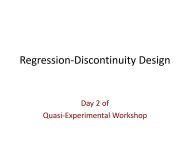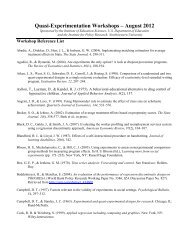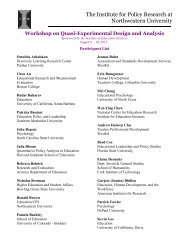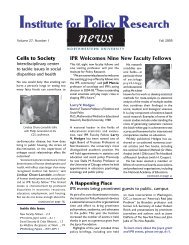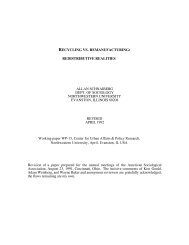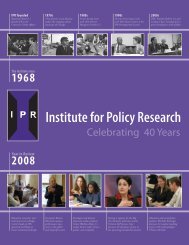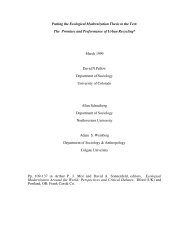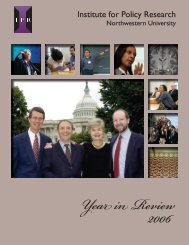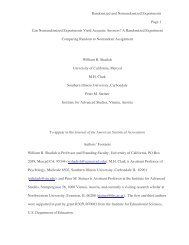Highlights of 2011 - Institute for Policy Research - Northwestern ...
Highlights of 2011 - Institute for Policy Research - Northwestern ...
Highlights of 2011 - Institute for Policy Research - Northwestern ...
Create successful ePaper yourself
Turn your PDF publications into a flip-book with our unique Google optimized e-Paper software.
Social Disparities AND Health<br />
their respective distances to the closest regional commercial<br />
center, the city <strong>of</strong> San Borja. More than 80 papers using the<br />
data have been published. More recently, McDade is involved<br />
with a project in Ecuador that has shown the regulation <strong>of</strong><br />
inflammation differs in this high-infectious disease environment<br />
from previous studies in the United States—a finding that might<br />
point toward ways to reduce levels <strong>of</strong> chronic inflammation<br />
that contribute to cardiovascular disease.<br />
About the Program<br />
Fathers Wired to Care <strong>for</strong> Children<br />
A widely reported <strong>Northwestern</strong> University study, coauthored<br />
by IPR biological anthropologists Kuzawa and<br />
McDade with doctoral student and lead author Lee Gettler,<br />
a <strong>for</strong>mer IPR graduate research assistant, provides compelling<br />
evidence that human males are biologically wired to care <strong>for</strong><br />
their <strong>of</strong>fspring, conclusively showing <strong>for</strong> the first time that<br />
fatherhood lowers a man’s testosterone levels. Their study<br />
followed a large group <strong>of</strong> men—624 males aged 21 to 26<br />
years old—<strong>for</strong> four and a half years in the Philippines. These<br />
men were not fathers when the study started, and those<br />
who did go on to become fathers experienced large declines<br />
in testosterone levels. These findings suggest that much like<br />
other mammals, in which males help care <strong>for</strong> the young, trade<strong>of</strong>fs<br />
exist: Testosterone boosts behaviors and other traits that<br />
help a male compete <strong>for</strong> a mate. After they succeed and<br />
become fathers, “mating-related” activities might conflict with<br />
the responsibilities <strong>of</strong> fatherhood, making it advantageous <strong>for</strong><br />
the body to reduce the hormone’s production. The reduction<br />
could also help explain why men who become fathers might<br />
have better health than men who remain childless, protecting<br />
them from disease as they age. The study was published in the<br />
Proceedings <strong>of</strong> the National Academy <strong>of</strong> Sciences, and picked up<br />
by national and international media, including The New York<br />
Times, The Wall Street Journal, Scientific American, USA Today, and<br />
PBS Newshour. The National Science Foundation (NSF) and<br />
the Wenner-Gren Foundation supported the research.<br />
Low-Income Dads and Kids’ Health<br />
For the first time, a study has examined how low-income,<br />
urban fathers are involved in their children’s health. The study,<br />
led by pediatrician and IPR associate Craig Garfield, focused<br />
on 31 primarily African American and Hispanic fathers from<br />
Chicago and Milwaukee who were an average <strong>of</strong> 31 years old.<br />
The men were a subsample <strong>of</strong> the national Fragile Families and<br />
Child Well-Being Study. Of the sample, 55 percent were single<br />
and 41 percent had an income <strong>of</strong> $34,999 or less. More than<br />
half <strong>of</strong> the fathers reported modeling exercise behaviors and<br />
engaging their children in play as ways to promote their child’s<br />
health, the study reports. The fathers said they knew their<br />
behavior influences their children’s habits, and they <strong>of</strong>ten tried<br />
to set a good example. While fathers had no difficulty telling<br />
their children to eat more broccoli or run a lap, they were less<br />
Thomas McDade, Chair<br />
IPR’s Cells to Society (C2S): The Center on<br />
Social Disparities and Health continues to<br />
expand its scope <strong>of</strong> activities to understand how<br />
social, economic, and cultural contexts affect<br />
physical and mental health, as well as cognitive<br />
achievement, at the population level. Faculty<br />
research overlaps with other IPR program areas,<br />
including Child, Adolescent, and Family Studies;<br />
Poverty, Race, and Inequality; and Education <strong>Policy</strong>.<br />
com<strong>for</strong>table dispensing medicine or handling an emergency<br />
room visit. Given the number <strong>of</strong> single dads, stay-at-home<br />
fathers, and the general increase in father involvement overall,<br />
Garfield calls this a “wake-up call” <strong>for</strong> healthcare providers to<br />
include and educate fathers as key partners in their children’s<br />
health, rather than exclusively focus on mothers. The study was<br />
published in the Psychology <strong>of</strong> Men and Masculinity.<br />
Brain Energetics and Evolution<br />
Kuzawa is collaborating on a five-year, NSF-funded study with<br />
geneticists and research scientists at Wayne State University that<br />
explores why the human brain learns so quickly in childhood<br />
and adolescence and then tapers with age. The brain consumes<br />
enormous amounts <strong>of</strong> energy in the <strong>for</strong>m <strong>of</strong> glucose during this<br />
learning ramp-up. By comparing human glucose consumption in<br />
the brain with that <strong>of</strong> primates across their respective lifespans,<br />
the researchers hope to identify differences between the two<br />
and pinpoint what gives the human species its extraordinary<br />
cognitive abilities. In an article <strong>for</strong> PLOS ONE, the research team<br />
sheds light on humans’ extended juvenile period during which<br />
the brain is more plastic as compared with primates. The team<br />
studied 37 samples <strong>of</strong> cerebral cortex tissue, obtained with<br />
consent from patients between 1 and 57 years old already<br />
scheduled <strong>for</strong> brain surgery. Adjusting <strong>for</strong> a person’s gender,<br />
they divided the samples by age, comparing gene expression<br />
patterns in children and adults. They found much greater<br />
variation in which genes were expressed (“turned on”) in the<br />
children when compared with the adults. Of the 302 genes that<br />
21



